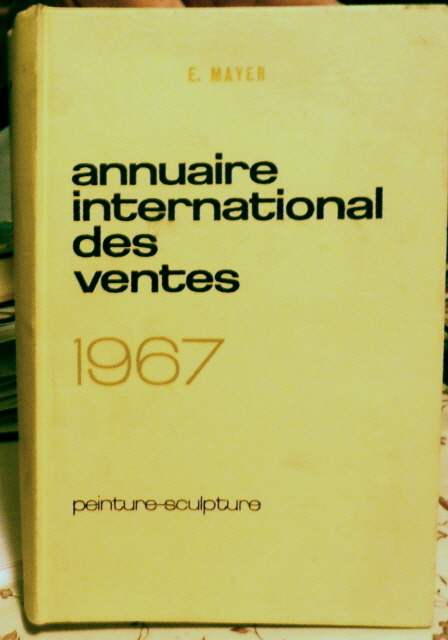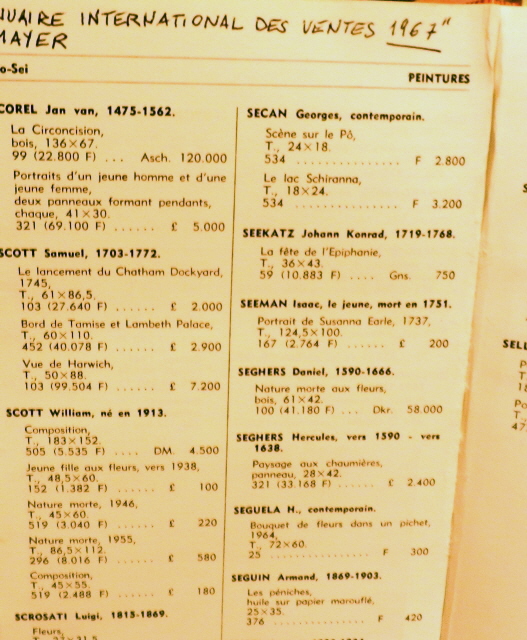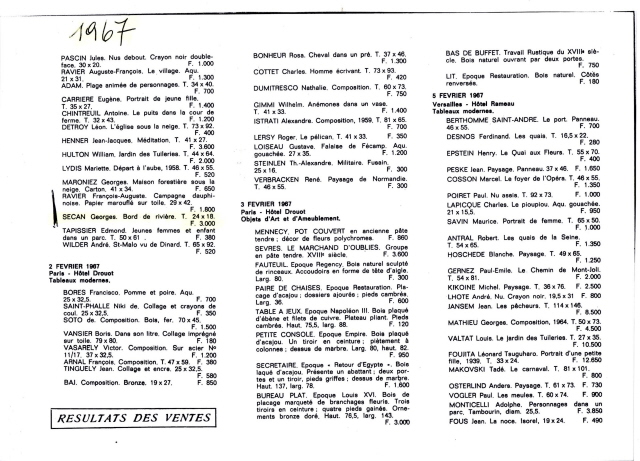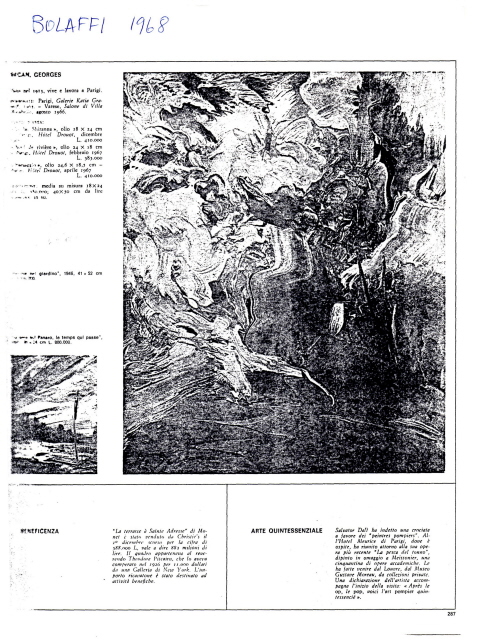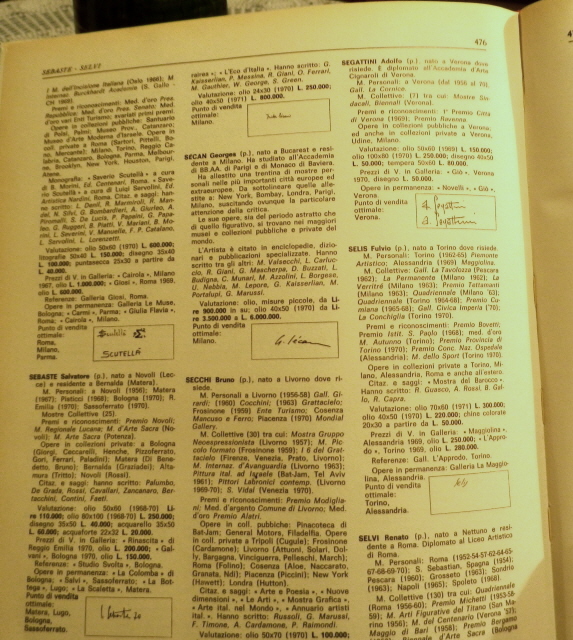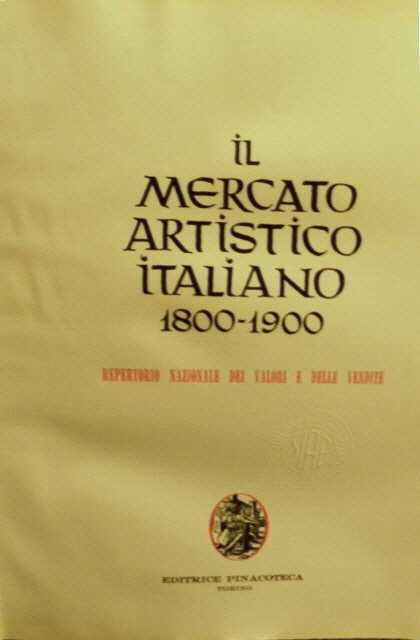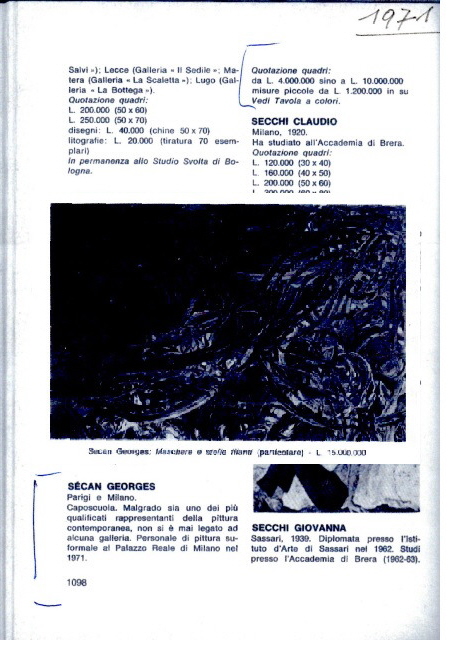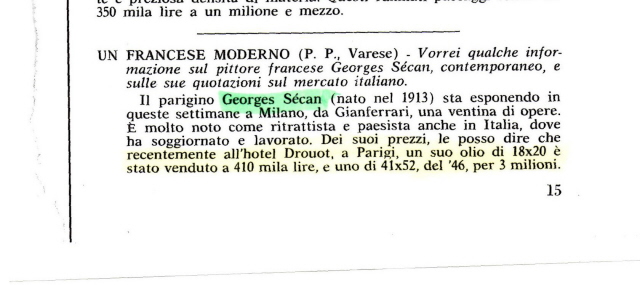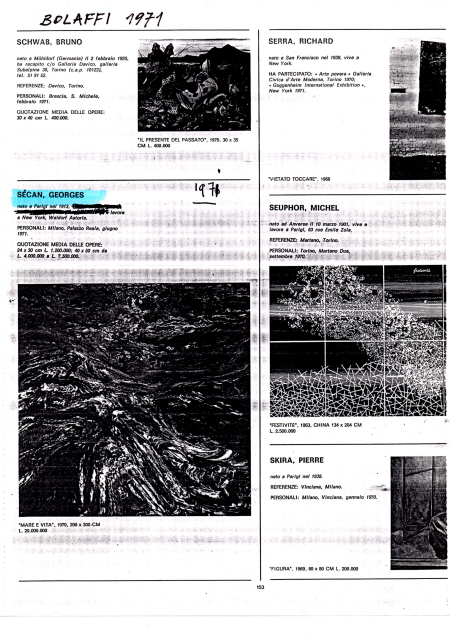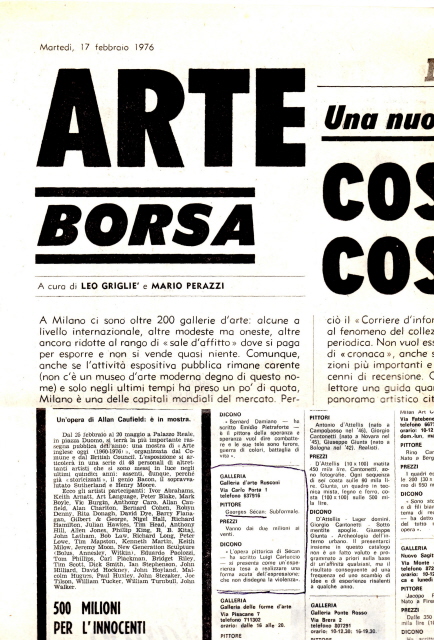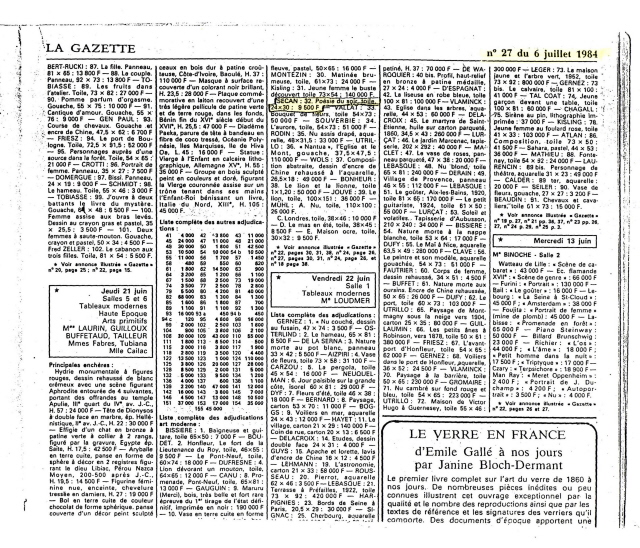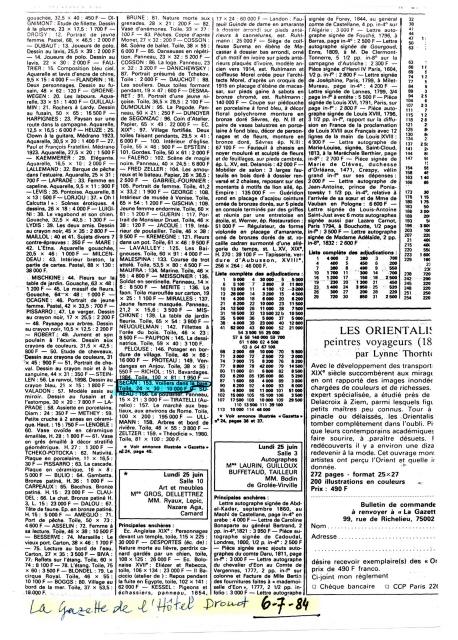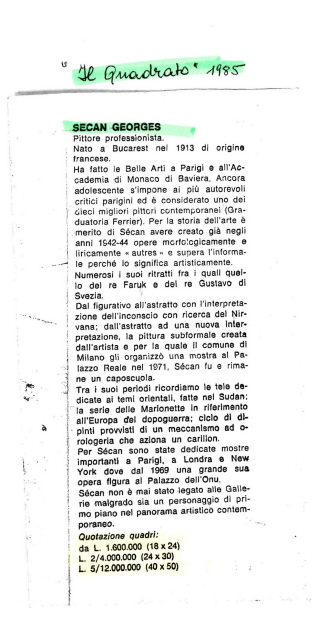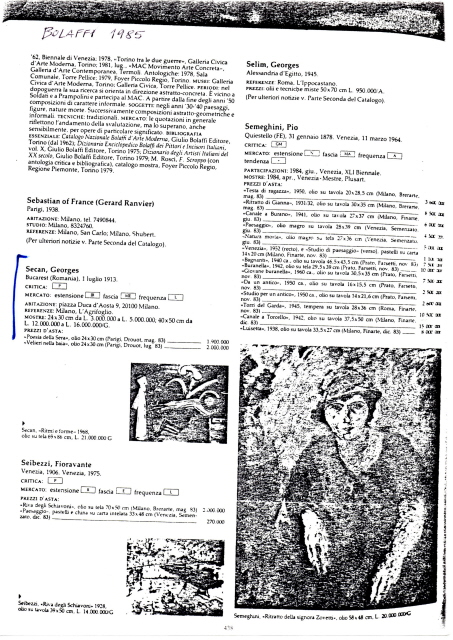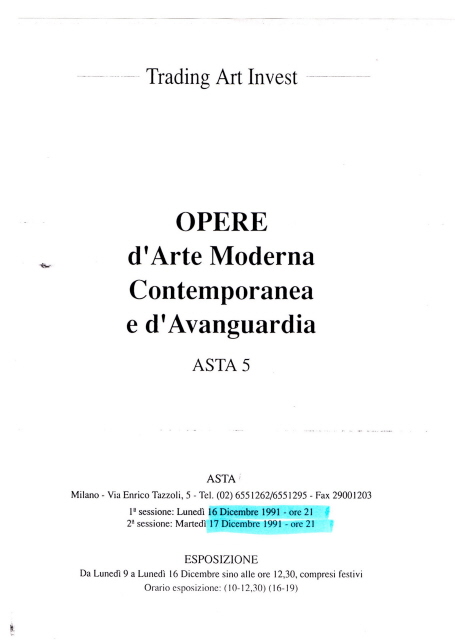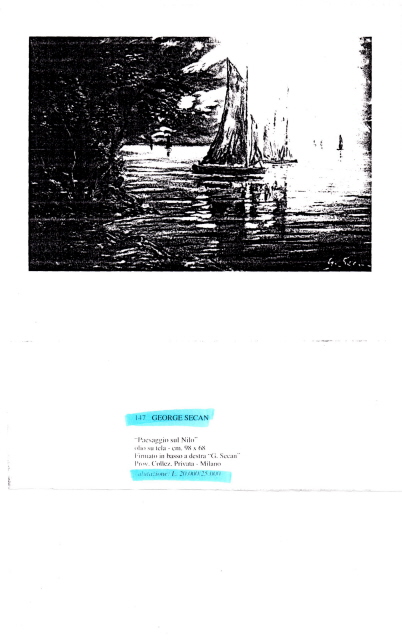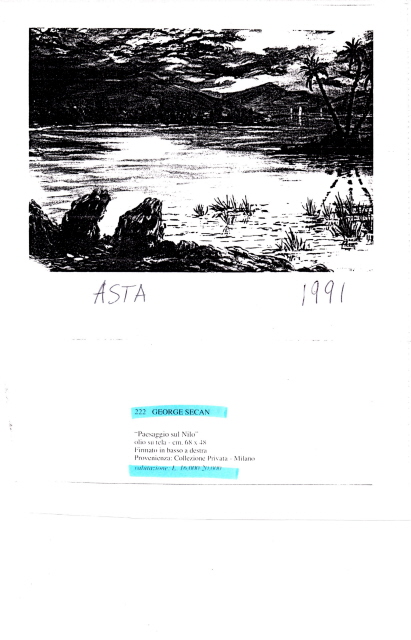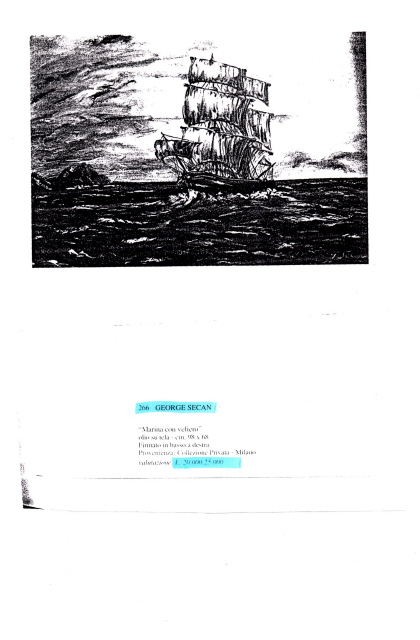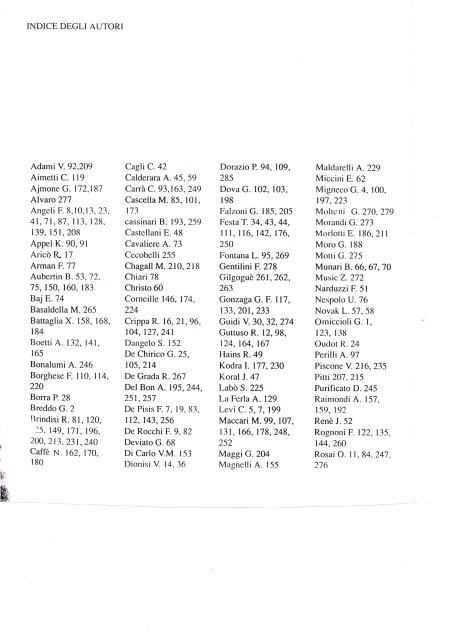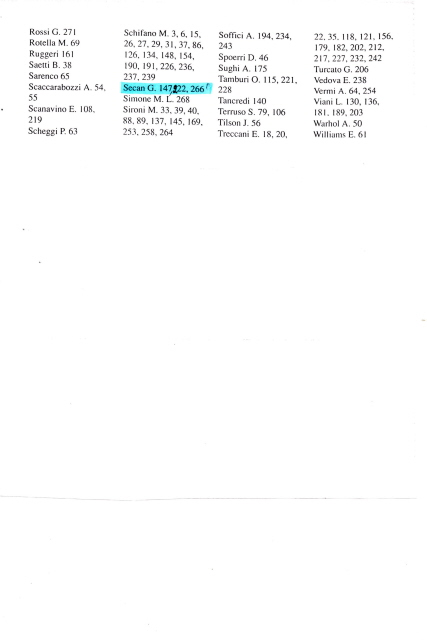|
From the Italian Art Encyclopaedia 2013
SÉCAN Georges
G. Sécan (1913-1987) was born in Bucharest, the
son of a French vice-consul and a Finnish woman.
He studied Fine Arts in
Paris and
Munich,
getting several awards and winning important
competitions since he was eighteen.
He
lived
for
long
periods
in many European and
extra-European countries, gaining
experiences
which
left
deep marks in his pictorial work. On
many occasions he was inpired also by Italian
landscapes. Remaining out of the main artistic
currents
as well as
of the galleries
and
art
merchants’ world, he has
however
succeeded
in
achieving an
international
reputation
thanks
to
the widespread success
earned among
the best
critics
and
among
the general
public.
In 1941, he created
a new kind of painting
that
he called «
Subform ».
Tapié redefined « Subformel » that
kind of painting in which the artist tends to
express himself straying completely from
himself,
In
the
attempt of
finding
again
a lost
ancient
tune, the
one
of the primitive man
in
front of
his simple and truest subconscious.
Sometimes,
that
engagement
leads to
a transfiguration of
the landscape or
simply of
a rhythmic sensation
into
images
whose
extreme
expressive violence,
as well as
the dazzling
intensity
of
colours,
has few comparisons in contemporary painting.
VALUE
This
great
artist,
who
died
over 25 years ago,
has
never
had
art merchants
or
Galleries
as reference, certainly because of disagreements
he suffered in his youth with the
above-mentioned art operators.
Thus it becomes nearly
impossible to give a correct economic evaluation
to this excellent master’s work.
We
can only remember that, in the 70s, in the
period when Sécan was invited
for a one-man
exhibition at Palazzo Reale
in
Milan,
immediately afterwards
Picasso,
the value
of his
works had internationally reached notable
figures.
|
From the UTET
Encyclopaedia
Georges Sécan,
French painter (1913), was born in Bucharest to a French
father (the then Vice-Consul in Bucharest and a Finnish
mother. He studied art in Paris and Munich, winning various
awards and important competitions from the age of 18
onwards. A wandering spirit, he has sojourned at length in
countries in and outside Europe, including India, the Sudan
and Egypt. The experiences he gained from his journeys have
left profound traces on his painting. On numerous occasions
Sécan has also found inspiration in Italian landscapes.
Whilst remaining apart from the main
artistic currents ( although the recall to expressionism is
not out of place), as well as from the world of galleries
and art dealers, Georges Sécan has nevertheless attained
international fame as the result of the open praise on the
part of both the most important critics and the public,
thanks to his prestigious exhibitions.
With a warm
and vigorous brush-stroke, and an exceptional sense of
colour, Sécan is the creator of a new genre of painting
which, in 1941, he called “Subform” ( forms let loose from
the profound subconscious). Tapié, on the occasion of an
exhibition organized for Sécan by the Municipality of Milan
at Palazzo Reale, redefined this kind of painting “
Subformel” in which the artist tends to express himself by
his complete detachment from himself in the attempt at once
again finding an ancient, lost understanding that of
primitive man faced by his simple and truer subconscious.
This commitment is sometimes translated in the
transfiguration of the landscape ( a sunset, a sea-bed) or
simply by a rhythmic sensation images of an exasperated
expressive violence which, like the blinding intensity of
the colour, have few equals in contemporary painting.
Georges Sécan
– European Enciclopedia ed.Garzanti
Georges
Sécan ( Bucharest 1913), French painter. After studying in
Paris and in Munich, after a figurative beginning, yet
already attentive to abstract influences, he left Europe
and, in India, he came in contact with Zen philosophy,
which led him to deepen his researches of
“self-contemplation”: that way, there were born the
psychological presuppositions of a painting which, in
1941, with a notable advance on the informal vague, he
presented like subform painting ( forms sprung from the
subconscious) At its roots there is a condition of ataraxy,
meant as a mastery of a psychical store, a sort of vital
surplus operatively transferred into an extremely vehement
colouristic and visionary surplus ( Precivilization, 1961,
Lausanne, Musée des Beaux Arts): it’s a technique which,
if on one hand it seems to approach Sécan to the so-called
abstract expressionism and to Cobra Group – which, at a
certain point, he seemed to get near – it actually differs
from them, because of its stating as authentic revelation
of the subconscious, the element which distinguishes Sécan
also from Surrealism ( seen as automatic recording of
Freud’s individual repressed instincts ) and rather
connects Sécan - in his mediation between East and West –
to the world of archetypes populating Jung’s collective
unconscious. Thus Sécan’s work alternates themes ranging
from the art of portrait to musical notations, from
Eastern landscapes to the series of “marionettes”, which
the artist painted in Paris after the war, as a dramatic
note picked among Europe’s ruins.
From the Universal Encyclopedia SEDA
A first-rate personage in the current
artistic view, perhaps Sécan represents one of the most
precious examples of that cultural internationality able to
give a determining incentive, on the poetic and human plan,
to the historical community of the great cycles of art. All
Sécan’s life runs through a thick intertwining of events, of
journeys, of meetings. Become famous while still very young,
with great sacrifices and not few disillusions, he had to
conquer the inestimable richness of his freedom. In fact,
after bitter experiences, he decided to make his demanding
pictorial speech advance, in a totally autonomous way,
beyond the ambit of galleries. From that always renewed
determination, his spirit progressively gained that
consciousness and that rigour which very soon claimed the
most qualified critics’ attention and the most exigent
public’s one. A very highly-cultured man, friend of the
greatest artists of our time, Sécan gave birth to a series
of pictorial cycles which coincide with the various phases
of his restlessness travelling, as philosophical messages
and as expressive sensitivity. In the space of his very
productive activity we can number the paintings inspired by
the Buddhist philosophy, direct result of his stays in
India; the canvases dedicated to Eastern themes, conceived
in Sudan; the series of marionettes, dramatic annotation
picked among the ruins of Europe after the war; the cycle of
moral paintings, which ranges paintings supplied with a
timing device starting a carillon ; the series of
“Reactions” ; the space-temporal researches.
"I know I have found new and original
accents for my painting, searching another self in myself,
trying out further layers of subconscious, primordial,
rudimental, metaphysical ones, completely unrelated to the
usual vision of the psyche – layers which don’t reconnect
anymore to us since millennia. From this marvellous journey
through the realm of spell, - an unperceivable almost
abstract heritage – I, moved and upset, get original
impulses, uncanny expressions, new visions, in the land
beyond myself. " ( Georges Sécan)
Georges Sécan, French composer and painter ( Bucharest,
1913). He studied Art of Painting at the Julian Academy in
Paris and, for music, he was a pupil of G. Enesco’s ( violin
and composition). Together with his main
activity as a painter, - he will cultivate successfully,
also later, the passion for music. He published many works
favourably welcomed not only by the public, but also by many
great musicians of our time: among his most appreciated
works, we mention Bizarre Dances, a Trio in D
Major, a Brilliant Fantasy, this last one
dedicated to Yehudi Menuhin.
(Encyclopaedia of Music, ed. Curcio)
( from the book “ Subform Painting” by G.
Sécan, published by Garzanti )
Art-Life by G.Sécan
Art is projection of life. To speak of my
painting, I have to speak of my life, my way of thinking.
It is often thought that a painter is a
profligate, a libertine who delights in searching for the
most dissolute amusements among debauchees in Bohemian
circles. I have never been part of such a group, and my
life, starting from my adolescence, has been dedicated to
ideals of virtue, to artistic and philosophic interests,
rather than to material things. It is useless to recall
here, as I did in “ Mes Confidences”, the times when I used
to meet Brâncusi, Picasso, Braque and others who had not yet
become the “ monstres sacrés” of our days, or the bizarre
“combines” of the art market.
I have never felt like following a style
or a way of life which was not compatible with my own
idealistic conviction. So I have not only remained almost
always isolated from painters, their circles and trends, but
I have also avoided any connections with dealers and
important art gallery owners, despite their insistent
requests, simply for the love of my own freedom and my own
ideas.
At 16, I think I can say it, I was
already a painter: my paintings were liked, and I was
considered one of the best at the Académie des Beaux-Arts
Julian in Paris.
Without interrupting my studies at the
Académie, I obtained work teaching art in a girls' convent -
boarding school – and later, because I was reliable and my
students achieved excellent results, I had other pupils to
whom I gave private lessons. I was alone, however, without
friends or relations, incapable of organizing myself; and
if, as sometimes happened, my lessons were paid several days
later, or if I did not succeed in selling a painting, I
would go without food for days. Another cause of worry for
me was always trying to appear tidy and respectable, with
clean, neat clothes, especially when I lacked the minimum
necessary for food. But I did not give up, I succeeded in
overcoming the difficulties. I was a supreme optimist, and
did not want to submit to the requirements of the gallery
owners. The only thing I had was my freedom ( which also
meant isolation). My thoughts detached me from a practical
side of life, from reality, and the idea of being provident
was foreign to me.
When I sold my works the money only
seemed mine if I spent it, especially to buy books, and I
soon had no money left. In addition to my great passion for
art, I felt myself drawn to seek for something beyond
myself. If I painted outside, in front of an inspiring
landscape, I abandoned myself to prolonged meditation,
allowing my glance and my spirit to wander beyond the limits
of the horizon. I felt that art gave me the sense of a
truer existence that overcame the artist, stimulating me to
a more profound life, to a “ surplus” of the mind. I loved
to read books of ancient Greek philosophy and I was
frequently assailed by metaphysical problems..
Often, waking in the middle of the night,
I remained for a long time in the dark, trying to understand
the mystery of Creation and, as I wrote then, “what this
existence so firmly attached to me, this ‘I’ on which I
depended blindly, hid under its stranger’s mantle “. I
found only one reply to my distressing problems: “Life is
nothing, man is nothing, all is closely linked to Nothing. A
supreme Nothing which, despite its right to ‘be’ before
anything whatever, was inconceivable, could not exist except
attached to Everything”. Thus, I thought that the law of
Equity – Nothing-Everything – remains in force for all
eternity.
These were thoughts that tormented me,
notwithstanding my faith in God, while in the great and
cruel city of Paris I was perhaps one of the poorest and
most solitary student of the “ Beaux – Arts”.
Moreover, I had to live hidden from my
family since they would have taken me back into the fold and
prevented me from following my vocation as a painter. I
had to try never to be noticed by the police or by anybody
else since I was a minor who had left home without his
parents’ consent, without documents. I had always to make a
good impression, hide my poverty. I did not live like other
young men, and dancing, amusements, girls, and taking part
in the hair-raising parties of my fellow students seemed
prohibited things to me in those days of study, philosophy
and deprivations.
My thoughts were of little interest to my
companions at the “ Beaux-Arts”, who busied themselves with
the galleries and critics, and a calculating search for a
successful style. Further more, they already had their own
habits, amusements, friendships, families and I was still “
the foreigner” even though I was French like them.
In order to achieve a life which was
truer to myself, more authentic, to subtract myself from
stupid officialdom, the grip of false and servile
conventions, and the dealers who promoted only their own “
stables” of painters, I decided, in view of possibly
abandoning Paris for long voyages, to perfect as far as I
could my painter’s craft. I may now say that, thanks to
this decision, I soon succeeded in making a name for myself
as a painter without the help of any gallery or any dealer.
Rather, little by little, deceived and deluded by an
avaricious gallery owner, I developed a kind of rancour for
all of them, including the honest ones, and subsequently I
have never agreed to alter my ideals for then, to sacrifice
my dreams, to allow the cold and mechanical practicality of
astute market organisations to make any impositions on my
visions as an artist.
This had an infinity of consequences in
my life. But from the artistic and human point of view,
this determination was precious to me. I have found
propulsive forces in myself, in my passion for art.
And this is why I have never allowed
gallery owners or dealers to handle my work.
Already isolated by my ideas from my
colleagues and from the galleries, solitude began for me
with all its bitterness, even before I started out into the
world. And, curious destiny, it has lasted an entire life,
without family, home, affection, always and everywhere like
a foreigner.
And my fate of being a solitary and a
stranger continued thus for all a lifetime: from Paris to the
many, many other cities where destiny took me. However,
being passionately interested in philosophy, I also learnt
to detach myself from myself, first with ataraxy – a serene
state of mind, protected from perturbation – and then, with
that kind of Zen which I derived from it, to paint, and to
isolate myself in some way from any noisy atmosphere in
which I might find myself and from the onset of
preoccupations.
Circumstances led me, after Paris, to
spend a great part of my life in the Orient. My shy and mild
character, inclined to tolerance, yielded still further to
its tendency to respect and love of my neighbour, and to
generosity which unfortunately has also brought be much
grief.
It is difficult for those who have never
lived in the East to understand how, especially with an
artist’s sensibility, if one is not pessimistic or irascible
or too egocentric, in those places one feels oneself
naturally attracted towards the virtues and values of
goodness, towards the beneficence of thought, and that
remarkably precious something that is true altruism. Perhaps
one is able metaphysically to receive more elevated and
spiritual messages from a hotter sun and a bluer sky that
the usual skies of Europe. In those gardens which are always
green, with that sun which exalts life, there was something
intoxicating in the air stimulating one to do good.
In the years when I was a painter artist
at King Farouk’s Court, I was in great demand by the most
important families as a portrait painter, and success and
money enabled me to live well. I became involved in many
charitable institutions, and among other things I was an
active member of the Committee of the Heliopolis-Cairo
Orphanage. When one has not assimilated the ways of thinking
and feeling which prevail almost everywhere in the East, how
absurd certain situations seem which are the result
precisely of their fatalism, of spirit of submission and an
excess of oriental indulgence! A lot of problems occurred to
me just because I had been influenced by the environment. I
became fond, from among other children, of a little girl who
was not yet three, taciturn, always ill and who walked with
difficulty whose mother, although of Italian origin, worked
during the war in the bars and other places frequented by
the Allies. Her daughter lived in such an unsuitable
environment for a child that I decided to do something about
it.
Later, as time passed, I came to
recognise, that what I had done for the child and her mother
had never created the least sign of gratitude in them but,
on the contrary they both caused me grief and shame. I
only found consolation and refuge in art and in solitary
meditation. This existence of mine in pensions and hotels
finally came to an end when I married in 1972. For the first
time I found the sense of comfort given by having a home and
family which, after a difficult life, have granted me a
happiness until then unknown.
However, it is true that for me solitude
was a source of meditation and concentration. Even more than
my life itself, it was my thoughts which gradually led me to
subform painting. Having finished my studies at the Académie
des Beaux-Arts Julian, I spent a year in Munich to perfect
them and then returned to Paris. There, thanks to the
generous Rothschilds and to Waldemar George, the most
authoritative art critic of the time, my works soon became
sought after.
Whilst painting a landscape I avoided
technique and skills in order to allow myself to be
penetrated and inebriated at length by the sense of mystery
and the boundless sky, trying to paint only in reaction to
intercepted sensations, in the studio I abandoned myself to
abstract painting, I left myself be guided by fancy,
impulses, feelings of the moment, not without searching in
myself, anxious to intercept and record on the canvas some
sensorial perception, key to our human condition, the enigma
of existence.
It was from my painter uncle that I
learnt to look better into myself. In a corner of his studio
he kept a poster on which was written “Try to be yourself”,
a saying of which he often reminded me. It impelled him to
be more attentive to the impulses of his soul than to
technical skills. Thus this precept so dear to my uncle
spurred me on, little by little, to seek for the real
meaning of being.
What led me, however, to more complete
introspection was reading Epictetus’s famous manual. These
maxims for living which were held in such esteem by Marcus
Aurelius, Pascal and Napoleon, made my existence less
precarious spent, as it was, almost entirely between one
country and another, with that feeling of a person isolated,
of a “stranger” (“tubab” as I was called in Senegal, or else
“European” in India, or “Kharedji”, “ostaz” or “huaga” in
other countries).
It was the Manual, modified in accordance
to my artist’s sensibility in order to avoid the stoics’
egocentricity, which led me to that imperturbable state of
mind, the ataraxy, which proved so influential in my moral
artistic formation.
I believe that interior research does not
only serve to deepen our faculty of thinking, but enriches
the soul with new perceptive faculties and gives us an
extreme degree of receptivity.
From childhood, as I often heard said, I
liked to look for a long time at the starry sky, and my
first desires were to posses the moon, the stars and the
trees. Perhaps this is why at one time trees were rarely
absent from my landscapes, not so much as a link between
earth and sky, but as a psychic liberation, or as a gesture
of rebellion.
As I have already said, I have always
looked for a reason in the mystery of the Creation. The
Bible and mythologies say that “…first there was chaos”,
identifying chaos, space, with Nothing. For me, space was
not in fact Nothing, but rather, in its so simple and
authentic essence it was one of the most extraordinary
structures of the Universe: it served as a container for
anything whatsoever.
In my adolescent mind, I convinced myself
that all things in nature conformed to a kind of dialectical
Equilibrium, to a sort of “Equity”, and that our most exact
sciences with their infallibility, so often demonstrated and
re-demonstrated, had developed in accordance with this
rule. I realized that Everything inclined towards Nothing,
that it became entwined with Nothing. The Yes with the No,
the definite with indefinite, the before with the after. An
affirmation always existed as a function of its own
negation, as happens with every life, for each specific
thing. And if the Universe mirrors its Creator,- I
ingenuously thought – also He, avoiding usurpations, ought
to be composed of two equal forces, in dialectical
opposition: “the Creator-non-Creator”, the Lord of Yes and
the Lord of No.
Thus, in this union of opposites in which
everything is annulled, I asked myself would it not be more
natural if there were only the absolute Nothing in the world
in all its supreme purity? But how could that which is
non-existence itself be made to exist? A Zero-space would be
necessary, which could not contain the least thing either in
itself or near to it, and a Zero-time so that it might
endure in eternity not bound to the present or the future.
But such a Zero-space and Zero-time are
inconceivable. The absolute Nothing , having neither Space
in which to put itself nor Time in which to endure, cannot
exist by itself. And if it cannot exist in its uniqueness,
it exists in multiplicity, bound to the Everything in the
Nothing-Everything.
In the spirit of the dialectic
Equilibrium which governs the Universe, each affirmation is
confirmed by its negation. On the other hand, is not the
Nothing-Everything confused with the Nothing? During my
adolescence these thoughts lived in me like grotesque
characters from a novel. I even tried, with laborious
reasoning, to empty the world of all Creation; however, when
nothing was left, there remained Space, the marvellous
container impossible to reject, impossible to eliminate by
any stretch whatsoever of the imagination. And I was
astonished to perceive in the impenetrable Nothingness,
which should have had supreme priority over all Creation, a
divine symbol, a fascinating purification of the world in
the absolute.
Its impossibility to exist by itself
seemed to weigh on the Cosmos like a kind of “original sin”,
in a continuous expiation, in the alternative
existence-non-existence. In all things one realized the
sense of annihilation, even in the supreme moments of
spirituality, love, contemplative ecstasy… Almost as if it
were Nothingness which imposed itself on all the Cosmos, on
all this universal Tower of Babel, built on contrasts as the
only thing better-defined: as dialectical Equilibrium, like
a kind of metaphysical Consciousness. It is upon this Spirit
of Equilibrium – I thought – that everything is constructed
and is destroyed in Nature.
The Everything in Nothingness, one thing
within the other, from the spasm of hunger to the quivers of
love or death, all things seemed to be dominated by the
longing to fill a void, by the desire of one half of the
world to devour the other half in order to live, so as to
exist.
The Universe is eternal, without
beginning, but given - as the fundamental rule – that the
first element which anything requires in order to exist,
even Nothingness, would have found a Space in which to put
itself, there is in nature itself the irresistible need for
one thing to interpenetrate another: the need, that is, for
Movement, the eternal law of creation and of life. On the
other hand, to put or to remove, to be born or to die, must
all be one for the impartial Equilibrium which can only
mingle, ad infinitum, the one within the other, in order to
arrange things.
A continual flight, protest against any
definite thing. This formula of One-thing-into-another, so
puerile as a principle, does not clash with the other
fundamental laws of nature. All these laws tend to be as
close as possible to the insignificant, to the Nothingness.
Everything tends to escape, to evade
reality. This is also seen in the continual transformation
of things. A wood destroyed by fire, swallowed by
earthquakes, by other cataclysms, by thousands of years,
becomes coal and petroleum, it burns, evaporates and so on,
following the eternal principle of “not being that which it
is”. Also time reflects Nothingness with its present which
has hardly appeared when it becomes the past, and with its
elusive future.
“ Is it possible”, I asked myself, “ that
the same grotesque sort of existence for Nothingness happens
to such an extraordinary Creation as it does to each created
thing?”
In those years of fanciful meditations, I
imagined space made up of an infinity of small dots which
continually rummaged in themselves in search of the smallest
possible one. They were like spirals which clung together
increasingly more frenziedly, more dizzily, converging
towards an ever smaller space. Close to the untouchable
Nothingness they exploded and returned in the opposite
direction towards a larger space where they were immediately
absorbed by the other, stronger convergent spirals. The
spirals, clashing and converging among themselves,
undifferentiating the various degrees of density and
strength of space, in the end wove matter. I thought that
they had always existed in space and that new solar systems
like our own, continued to be formed.
These were not arguments which intended
to undermine religious opinions – faith is a sentiment of
the soul which one possesses with an authentic echo of
oneself.
Certain peoples have a religious vision
of Nothingness. For an Indian, for example, as the poet
Tagore told me in 1936, Nothingness is almost a sacred word.
It is impossible to explain these things to a Westerner.
The present does refute time, as in certain Indian temples,
and the soul tends to raise itself within the Infinite, in
the yearning for the Inexistence.
Even considering the East nearest to us,
it is not easy to describe the sense of metaphysical
emptiness which is created around the voice of the “
muezzin” as soon as he invokes “ Allah u Akbar” ( God is
great), calling the faithful from the summit of the mosque
to their humble prayers. And with such few notes, with so
much harmonious musicality:

How many times, before painting a
landscape from life, I have been overwhelmed by this emotion
which gives the infinity of the heavens. I would focus on a
distant point and then, using my imagination, I would move
my glance towards a still more distant point – and so on –
until I finally lost myself in the ecstasy of a new
sensation, transcendent.
And since I knew that, from light to
colours, from sounds to ultrasounds, every thing in nature
was organized on the intensity of waves, it seemed I was
tuned to a metaphysical wave length in Nothingness, in the
Infinite. It seemed to me that I had escaped myself, and I
intuited that there is the magical reflection of the before
and after life in us. And that Nothingness is precisely the
ideal to which each life unconsciously aspires. Also in
order to think profoundly of God, to express my humility in
prayer, I had to make a certain void in myself, annul every
egoistic instinct, to start out from emptiness, from
Nothingness. I seemed to be like a bird which had to flap
its wet wings before flying. Only by making a void in
myself, could I approach the mysterious divine Spirit more
closely, the unknown force which appeared masked by
Nothingness.
Christian martyrs, anchorites, Indian
santons and Zen followers have found the best moments of
their thought and faith in the absolute search of the beyond
of existence, in the sublimation of emptiness. Of that void
which commence with deep respiration of the mind and has
always something new, fresh as in the phenomena of nature,
something which lightens the banal pressure of life.
Perhaps by intercepting a fluid lost from this mysterious
Nothingness made physical, man goes beyond himself, he
approaches the ideal of attuning himself with the sublime
in a supreme God who annihilates the absurdity of the
Nothingness-Everything.
I learnt from Epictetus’s Manual, which is
a sort of moral summary of Stoic philosophy, to practice ataraxy. In Paris, as I have already said, at the time when
I attended the Académie des Beaux-Arts Julian, I alternated
my studies with lessons which I gave to various pupils at
their homes. In those years many parents preferred not to
send their daughters to the Académies and so, in often
having to move about, sometimes from one end of Paris to the
other, during these long trips I would practice ataraxy. I
reached the point of immersing myself in a serene state of
mind, safe from any external disturbance; I only allowed
myself to be influenced by things determined by me (state of
mind, opinions), and I ignored everything else which did not
depend on me, since it was outside myself. I conditioned
myself by way of two stages:
1 – Control of the state of mind in an
imaginary circle of isolation and defense;
2 – Control, within a larger circle, of
that which could infiltrate the area already controlled.
Subsequently, intensifying the
concentration after these two stages which produced ataraxy
in me, and going beyond the second circle, I reached the
point of confounding this state of mind with Nirvana, with
Nothingness. But here it was already “transpresence”, a sort
of void as it is referred to in the East, which I was to
discover better some years later. The vaster area of
perception around the mind, the more the latter is elevated.
This control is like a growing pressure which digs deeply
into our being. All of this, however, depends on an
ever-intensifying concentration.
With these three stages of concentration,
I gradually guided myself to Subform painting.
My practice was very different from the
ataraxy of the ancients Stoics (which also led to
insensibility and egotism). I had only to be subjected to a
control of myself, selecting my sensations. I thought with
greater lucidity, I was less a slave to things and I was
proud of profound by feeling the meaning of the Delphic
precept: “ know yourself”. In 1932, however, I received an
unexpected and violent shock which made me understand, in a
concrete way, our degrading reality: the Absurd. This was
the death of one of my pupils. One Saturday afternoon,
while I was going to her house for our lesson, I noticed –
and what horror the realization gave me later – that I was
humming the hackneyed theme of Chopin’s ‘Funeral March’. I
rang the doorbell and a person I had never seen before opened
it. Everything seemed strange; even the entrance was
plunged into darkness, while only a few days before, at the
previous lesson, the girl herself had let me in, as she
usually did.
“ I’m the painting teacher,” I said to
the unknown man. Then I heard a strangled, mourning voice:
“She was buried yesterday… Typhus…”
Alone, in the street, with the obsessive
Chopin still in my ears, I began to understand. I was
overcome by a deep torment and realized - only then – that
I had been truly fond of that girl who had been my pupil for
almost a year. The next day, in a small office at the
entrance of the cemetery where I went to find her, I
received a ticket with the number of the sector, the row and
the tomb… I found her name on a small rectangle of earth
which had just been dug over, and I left the first roses I
had ever given to a girl. In that deserted corner of the
cemetery – to which I often returned – and in the peace of
all those souls, something ineffable united me with them.
A profound change took place in me. My poor philosophy
became concrete not in order to accept death – and even
today I refuse this idea – but rather the Absurd,
Nothingness. In the deep silence which interpenetrated
everything, my thoughts became more acute. I even seemed to
perceive the petals’ farewell which detached themselves
sorrowfully from the roses, while I once again saw sweetly
within me that person and contemplated her luminous eyes,
her hands by way of the earth and flowers which covered her.
It was the first time that I had found
myself in front of this other face of human destiny and also
afterwards, during my solitary life without relations or
patrons of any sort, and without a country of my own, not
only did I remain detached from death and cemeteries, but
perhaps also from my own life.
I suddenly realised that reality was
conditioned and that Nothingness was the true key to all
things. Faced by those graves I asked myself whether
Inexistence, Nothingness were the precious ideal to which
each human being unconsciously aspires, and which we have
lost in the vortex of life. Maybe we only join one another
in death? I found it right that God should be the substance
of Everything, as also of Nothingness and that our destiny
be also His…
What can it mean – I asked myself – to be
beautiful and to be good, ugly and bad, when everyone
suffers and dies in the same miserable way? Or, perhaps, the
epitaph which would be appropriate for each one of us is
engraved on the forehead of the great Jupiter: Mort ou vif ,
Méchant ou bon, j’ai un seul nom: Contradiction…
I believe I wrote these lines, in fact,
at the exit of the cemetery in one of those peaceful cafés
which one existed – familiar homes of so many ‘solitaries’.
After this sad event I felt more than
ever disgusted by the environment in which a painter had to
make his way.
I decided to leave Paris. The Orient
attracted me and I took the opportunity of going to Egypt
where I painted important portraits. On arrival, some time
later, I discovered in Khartoum “transpresence” which I
derived from ataraxy. In order to isolate myself better in
my work, intensifying the concentration, I reached the point
of completely excluding what surrounded me, of reducing all
things to Nothingness. And when, after various efforts, I
also succeeded in attuning myself to the emptiness which I
made in myself, I began to paint.
Only in this way did I succeed in
finishing my commitment to Abbas Pascià for a whole series
of paintings which were to adorn his villa. The tropical
heat oppressed me and, moreover, I found myself in the
pre-war East and with all its comfortable precepts of life,
its fatalism and its famous “ Maàlesci” (everything’s
fine).
In the quarter where I was living, from
morning to night one only heard indigenous music; if at
first it annoyed me, I was soon so taken by it that I set
about studying it in earnest. These were ingenious chants
which conveyed laziness and languor; I realized how well–founded were
Aristotle's writings about the influence of
music on character and how right was ancient Greek law which
prohibited certain music. The environment had a negative
influence on me. I decided only to paint at night, using
large portable lamps (“à kabrit”) common in the East. And
here I began to prepare my colours on a large table with the
top transformed into a palette; also the canvases were
placed horizontally. When the accumulations of colours, the
lamps and all my other necessities were arranged, I took a
large flat brush with short bristles (so that I could also
use its metal ring) and, ready to paint, I concentrated on
isolating myself in the transpresence. In that environment,
unsuited to my painting, I had to make a great effort to
obtain this spiritual independence, and it was by way of a
certain reaction that I started my work, as soon as I
reached transpresence. Thus, before painting, not only was
the resentment and the confusion by which I was surrounded
cancelled from my mind, but once again manifested in me –in
my passion for art- were new and strong impulses. I
acquired the habit of often working at night, always in
this way, and the ease with which I could by now immerse
myself in the transpresence, which gradually exploded more
deeply, more than once gave me real interior satisfaction.
Later in India I came to know numerous
devotees of Zen and the Mandala and I was surprised to find
myself no less initiated than they were to the void, besides
the religious interpretation. Perhaps it was for this
reason that U Thant ( who before becoming UNO Secretary
General was also a Buddhist monk) with his enigmatic smile,
called my way of achieving emptiness "Zen-Sécan”, finding
it very personal. This self-contemplation of mine before
painting, coincided at certain points with philosophical
disciplines which had spread from China to India and Japan,
to hundreds of school and convents.
They taught, and still teach, principals
which are appropriate for the self-development of one’s
spiritual and physical faculties, with a gradual
accumulation in oneself of the maximum of psychic energies.
After long periods of training, one reaches
ever-increasing concentrations of repressed energies which
profoundly bear upon the elevation of thought in action and
on its lightning rapidity. For this reason, Zen is even
taught in gymnasiums in order to give athletes a better
awareness and mastery of their own forces. For example, in
archery (“Kyudo”), before shooting an accurate accumulation
of psychic forces, to be freed together with the loosed
arrow, is required. This principle of suspending action in
order to augment a liberated force convinced me more and
more that everything was generated in the contrast between
two opposed forces. Everything was connected to the
principal and creative spirit of the dialectical
Equilibrium. I realized that in Calcutta and Hong Kong the
sort of Zen and Zazen taught with recourse to notions of
emptiness in order to see better into oneself, was not far
from my way of identifying “myself” through that which is “beyond myself”. Also, through a sort of metaphysical
lucidity, I saw myself transported from the tranquil state
of mind of ataraxy to what I had called “the state of being
beyond myself” or transpresence. This new dimension, which
surpassed the depth of being, irradiated me in a space which
was beyond myself. Once I had entered into this
metaphysical state, in the acquisition of consciousness of
the soi-autre which makes the soi-meme so
precarious – so common – I not only had at my disposition
that psychic energy which accumulated in me, but also that
which surrounded me. And it was then that I perceived a
surplus of life which became sublimated in the agreement
between “me” and the “not-me”, transforming me – body and
spirit – into a single impulse: my being and the palette
became one and the same.
Still in India, in Calcutta, in 1941, one
of the most extraordinary event in my career as a painter
happened to me. One evening I returned home late. Before
going to bed, I noticed that my palette still had to be
cleaned. I had prepared it in the afternoon, ready for work,
thinking I would return early. Despite the fact that the day
had been very tiring, I decided to paint.
I set about concentrating myself as usual
but, as I was very tired, I did not succeed in keeping myself
in the transpresence: I lost it as soon as I touched the
colours. It was impossible for me to make the two efforts
simultaneously. It was in this way that, by compelling
myself to a more intense concentration, I completely lost
the idea of myself. I do not know how much time passed…
Suddenly I felt a tremor. It was a window
which was banging violently. And that brought me back to
reality. It seemed to me that I had momentarily slept:
although disturbed, I realized that instead I had painted
and in a state of deep trance.
I looked with astonishment at my fingers
covered with paint and at a large half-filled canvas. I did
not know what to think. The style of the painting was not
mine at all!... It was more alive, more dynamic than the
painting I had done in Khartoum affected by the state of
transpresence. I burst out laughing and felt relieved. “This time I have exceeded myself,” I said. “ I have just
returned from a life which is very different from mine”.
The half-painting was there, all vibrating with new forms
and colours in the full light. But I felt a deceitful
tiredness never experienced before. In the morning, when I
looked more carefully at the painting, I was enthusiastic.
The technique and the “fantasy” of the work were of a
clarity and originality which were unknown to me. I thought
that the too prolonged transpresence the evening before had
excluded me completely in order to make room in me for a
basic–subconscious, primitive which, continuously repressed
by our civilization, has not been mirrored in us for
millennia. I said jokingly to myself:” I have received a
visit…. Perhaps one of my ancestors came to see the most
recent creation of his progeny”.
I have always been attracted by
anthropology. I have tried, more than once, to imagine the
features and life of an hominid, of a man lost in the dawn
of time, of an ancestor to whom I owed my life.
I do not know why, but I showed this new
painting, still wet, to my barber and to other acquaintances
in the neighbourhood. They did not like abstract art
although I felt they were sincere in their admiration of
it. It was almost as though it touched a secret spring in
them – which is common to us all – the sub-subconscious. I
was certain that I had once again found an ancient and lost
awareness, that of archaic man faced by his simple and
primitive subconscious, more real that our own. I realized
that my pictorial alphabet had been enriched by new signs,
new forms and that that strange painting was a projection of
my subconscious.
This was why I thought of calling it “
subform”.
For two or three weeks I waited for the
evening to once again try to find the same creative impetus
in my oblivion. I persisted in attempting to relive each
moment preceding that singular trance. But I no longer
remember anything of importance apart from the decision I
had taken of immersing myself as far as possible in the
transpresence. I disappointedly realized that it was
impossible to find that kind of sub-subconscious painting
again, and I thought that it was precisely my instinct of
self–preservation, if not an unwitting prudence, which was
keeping me away from that “no man’s land”. Maybe I was
afraid to go back into that state of trance, to the limits
of being. Thus many days passed during which I was unable to
paint. Since for some time I had already intended to go to
new Delhi, I suddenly decided to leave. I was always
interested and enthusiastic when I could say :” I’m leaving
tomorrow!...”
It gave me an invigorating sense of
freedom. It was a recommencement, and when I felt the
monotony of my solitude, to leave meant to immerse myself in
a new life. Although “tomorrow” in India also means “never”, like the ironic “bukra” of Egypt.
Chance, that fanciful sprite which may
also play tricks on the disciplined severity of our cosmos,
which arranges and upsets our affairs, had me leave only
three months later because, and in the most unexpected way,
I rediscovered subform painting. I dedicated the day before
my departure to quick, last minute purchases. It was
already evening and I still had to say good-bye to some
acquaintances, including a picture framer. I thought that
he was the least important visit and that I would be able to
get through with it quickly, as was the case, although in
fact it turned out to be an extremely important visit.
The picture framer lived in an old house
in which, behind a main door, one had to go down a dark
narrow staircase and along his workshop-cum-frame deposit
which led to the basement. This finally opened onto a stone
staircase which had walls covered with drawings.
All of this complicated itinerary for an
almost useless visit ended up by exasperating me and I
hurried to go up the steps three at a time, freeing my right
hand as best I could from the packages with which I was
laden. My hand was lifted ready to knock as soon as I
arrived at the floor on which he lived, the fourth or fifth,
but at that moment I found it was inexplicably impeded and
held immobile. For a second I had the sensation of I don’t
know what, which was familiar and similar to another
interrupted movement. With my eyes fixed on that stiff arm
I suddenly remembered a detail which the trance of that
extraordinary evening had made me forget. The extreme
tiredness of that day had not allowed me, like other times,
to maintain the state of transpresence parallel to the
painting. Exhausted, almost in spite of my useless efforts,
and resigned by then to throwing away the paints, I had made
a firm decision: to maintain the transpresence for a short
time without allowing it to connect automatically with the
impulse to pain. I also remembered the tense arm which could
be restrained with difficulty in the effort of stopping
myself from making whatever movement, notwithstanding the
increasingly insistent pressure of the void.
Now, in front of the picture framer’s
door, which was still closed, I felt in me something like an
enlightenment; I seemed to become connected with the
infallible mechanism which led to the sub-subconscious. I
firmly believed in the force of the contrast which was the
creator of necessity, the universal basis of everything, of
our existence and of our civilisation.
Optimist by nature – as unfortunately I
still am, and too much so – I had the certainty that I had
discovered how to achieve a new painting. I went slowly
down the stairs. Everything seemed to be transformed. Even
the basement which led to the exit seemed to be more typical
than ugly. That evening I felt more immersed than ever in
the magical atmosphere of Calcutta, city of miracles. I
went to sit in the first café which I happened to find. In
that noisy little native meeting-place, in front of the
radio which gave out the latest news at full volume, I
decided to postpone my departure.
Painting was everything to me. In that
war period the Indian atmosphere was more that ever hostile
to Europeans. It was a diffidence which saddened me. I
felt instinctively close to the Indians and was conscious of
their rights and problems.
It is in these solitary and repressed
moments of life that the artist feels the most need to take
refuge in what he loves, in what he feels most deeply. He
tends to surpass himself in the desire to transform, to
create, to reflect himself in a new being, in a more
integral presence, beyond the “walls” of time.
Returning home, I thought at lengths of
how to prevent myself from being overwhelmed by the trance.
This time I was more afraid of the consequences which it
could cause me. On the other hand, I seemed to be going to
find a new Land, unknown, and that made me stronger. Having
returned to my room, I did not feel like concluding the
evening. Everything seemed extraordinary to me. I prepared
the lamps, took out the powders, the oil, and what was
necessary in order to mix my colours, remaining a little
detached from everything I did; I even remained detached
from myself, so alive in me was the intention of escaping
from things, of watching myself from a distance… I was
spurred on by the certainty of succeeding in once again
finding that new form of painting with such a profound and
luminous touch. I had the presentiment of deciphering a
whole secret world still alive in us, of being reborn
through art into a new dimension – more authentic,
essential, metaphysical. Although at the same time
something strange overcame me. I was afraid. A
profound, insidious fear, the fear of being swept away by a physically and mentally
risky experience.
In my often adventurous past I had
overcome ugly moments courageously but that evening I am
sure that I was really face to face with fear.
As usual, when the preparations were
completed, with the brush ready in my hand and everything
spread out in front of the palette, I began to concentrate.
Trying to repeat what I remembered of that far-off evening,
I forced myself to resist to the utmost my by now engrained
habit of starting to paint as soon as I had achieved the
transpresence. I had to force myself for a long time to
detach myself from reality, while at the back of my mind,
with my heart which I almost felt beating, I every now and
again felt a recall to prudence… I was in the vortex of two
equally strained opposites. The more the state of
transpresence intensified, the more difficult it was for me
to restrain the impulse of my arm to paint. Thus, while on
the one hand I proceeded, enveloped in the hermetic cloak of
the transpresence, in the grip of an increasingly greater
concentration, on the other I refused the almost automatic
impulse to paint, that profoundly acquired function
predetermined by the transpresence itself. It was like the
play of a spring which contracts and is then released, like
the increasingly growing alternation between receptivity and
reaction.
Little by little, I became
depersonalized, in a semi-hypnotic state, in the abstraction
of myself. Suddenly I had the sensation that everything in
me was blocked. I felt a moment of suspense!
Everything seemed magically to have
changed, and all of a sudden I realized that I was already
painting. A superhuman emotion brought me to the canvas, to
a mad palette and to a powerful hand which searched within
the open veins of the colours. It was not “ painting”, it
was existing in a new and more authentic dimension – it was
“ being”. I was no longer painting, I was creating,
substituting “doing” with “creating”. I was no longer
afraid. In the explosion of those frenetic, flushing
energies of painting, there was the accumulated anger of a
thousand repressed ancestral fears. I decided I would
always paint in that way. I was guided by a new dynamic,
which had its genesis in far-off times. This was reflected
by sudden energies in my process of painting which,
however, always corresponded to the rationality of my well
acquired craft of the painter which is, after all,
closer to the subconscious than to the will. Moreover, it
seemed that each brush stroke was in itself a point of
departure and of arrival, that it was born already complete,
it was so determinant. I realized that in the depths of our
being we are less the man of today than the homo semper,
a still green branch of the hominid. It is in this way that
the dynamics of my paintings are determined by this basic
instinct which drives me to the canvas to project that
throb of mysterious life which was once ours. In my
painting there is the significance of impulses and also of
messages which are not of our common subconscious, but of a
sub-subconscious, of that archaic one which affirmed itself
in us for millions of years and which we then repressed.
When I paint subform pictures I feel completely lost in
another world. The liberation of the impulses of the
profound instinct determines the presence in me of a
superior force, direct and uncheckable, which is freed by
painting. It is such a concentrated metaphysical dynamism
that it removes me from myself and from my way of doing
things, and transmits unknown and unlooked-for forms and
figures which, however, excite in me the affection which one
feels once again on seeing long-forgotten familiar people
and places. Often creations are born on the canvases,
perhaps reflections of realities lived long ago, which later
prompt me to be completed or corrected with some brush
strokes. Hence, the transcendency of the gesture which tends
towards the essential, the decisive and absolute touch which
reduces forms to the minimum, the impetus and passion which
overwhelm me, become fundamental elements of the technique
and spirit that the sub-subconscious imposes on me, taking
possession of me. My hand, my way of painting, my painting
experience, and also sometimes the reflection of a haunting
imagination or a recent impression, are also subjected
within the frenzy of the action to an instinctive force and
a metaphysical sense unknown to me. Immersed in a state of
semi-trance, perhaps suspended on a delicate thread of
awareness which keeps watch, which does not allow me to be
completely carried away, I look beyond reason and the
senses. I draw upon impulses, new and vitalizing energies
in that dimension which I could define as the “beyond” of
myself. It would be humiliating and useless to fill the
canvas with the well-known reflections of the man of today,
with his banal and unconscious impulses of repetition. I
leave my painter’s talent in the hands of a more natural
being, more resolute and without complexes.
In the subform, “creating”painting is different
from “doing”, also because the “doing” presupposes the
intention of carrying out something which one has in mind,
which one already knows, whereas “creating” is the “doing”
without knowing what the result will be. Life owes itself
to a sense of creation which excludes the intention of
doing: our living bodies of flesh were neither made nor
constructed, but came from a metaphysical Spirit which
induced matter to create life. Also the artist almost
always creates under the effect of a stimulus, of an
emotion, a reaction. Rossini found inspiration for his
compositions after enjoying his table, and Schubert in a
girl’s glance. Balzac stimulated his imagination in dozen
of cafés, and Michelangelo worked under the impetus of a
frenetic aggressiveness, connected, perhaps, periodically,
to his sub-subconscious. Sometimes, while I paint, I have
the sensation of vague and impatient shadows which are
latent in me, and as soon as these take on form and
character in the play of colours, I feel a singular
exaltation. This makes me believe that in my
sub-subconscious there is still a magma, still alive, of
repressed images. Painting has become for me more than ever
a psychic necessity which in the disposition of new forces
makes me aware of a more authentic life. In excluding
myself with meditations prior to entering the state of
transpresence, in the exaltation of Nothingness, I come
close to that truer and purer reality which was once ours.
Certainly one will never be able to once again find that
vitality which once existed, the authentic sense of
existence, of the metaphysical, which only illuminates us at
times. There is, for example, something profound and
fundamental which “starts” in my heart every time that my
glance meets that of my daughter. All the enquiring
tenderness that little Laura puts into her eyes excludes and
transcends man, distorted and deformed by a totally false
and conventional life. In those moments I realize that we
are always more subjected by conscience-comfort, by the
matter which we perfect and train to our service. We
objectify ourselves, we characterize ourselves in relation
to the objects which we believe we possess but which, after
all, possess us in the paralysing object-man monologue. We
do not realize that the triumph of matter is in direct
relationship to our decadence and that by dint of being
determined becomes determinant, and indeed it already tries
and condemns us…
These hands of ours, able and astute
tools as Shakespeare called them, must in their incredible
past have accumulated an immense store of knowledge and
skill. It was, perhaps, in order to free them that the
hominid chose the erect position. And who knows whether it
is not our hands’ prehensility and instinctive memory which,
indirectly, led our brain to receive ideas, to drive it to
the game of thinking and of the will, that basic
characteristic of man.
|
